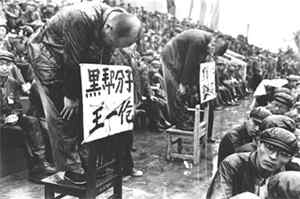
Pressure on children to “draw a line” between them and their condemned parents was intense and many did so. 11 Some people died from the beatings and torture. 10 Her mother was repeatedly told to denounce her husband but refused. Jung Chang, whose autobiographical book Wild Swans includes chapters on her family’s experience of the Cultural Revolution reported that her mother was subjected to about 100 such denunciations, some of them in front of crowds. Homes of the “Blacks” were raided and the owners were often subjected to “denunciation meetings” (also known as “struggle sessions”) where they would be made to kneel and were kicked and beaten with belts with metal buckles at the end. 9 If they did not, they might be accused of not being truly “Red” themselves. Once the Cultural Revolution was under way, “Reds” were told to shun “Blacks” even if they had previously been friends. 8 Children were defined as “Red” “Black” or “Grey” according to the status of their parents. People could be defined as “Grey” even if they were only office staff or shop assistants.
#MAO STRUGGLE SESSION PROFESSIONAL#
“Blacks” were from professional or bourgeois families as well as those who had sided with the Kuomintang or done anything to cast doubt on their loyalty to the Communist Party. 7 “Reds” were people from working class backgrounds or families who had taken part in the Communist revolution. People had been divided into “Reds”, “Blacks” and “Greys” prior to the Cultural Revolution but the division was taken much more seriously once the Cultural Revolution started. Red Guards removed or destroyed anything considered bourgeois, as well as anything connected to the Kuomintang, the rival force that had been beaten by the Communist Party in the civil war (1927-1949, interrupted by the Japanese invasion during 1937-1945). 6 School classes stopped and Red Guards raided private homes and ransacked shrines, libraries and shops. 5 In August 1966, Mao encouraged the Red Guards to destroy ‘old ideas, old customs, old habits and the old culture of China’. Student groups who supported Mao became known as ‘Red Guards’ and were encouraged to model themselves on military units.

4 Students and school children had been brought up to revere Mao and they responded to his call. Newspapers urged the masses to ‘clear away the evil habits of the old society’. The ‘May 16 Notification’ stated that the Communist Party had been infiltrated by counter-revolutionaries and revisionists. The Cultural Revolution began in 1966, following the release of the ‘May 16 Notification’, endorsed by Mao. 3 (For more about the senior rivals and opponents Mao purged, see the list below.) 2 The Cultural Revolution enabled Mao to reassert his status and to demote or destroy political rivals, such as Deng Xiaoping, General Secretary of the Secretariat, and Liu Shaoqi, President of the People’s Republic of China. This policy had led to widespread famine estimates of the resulting deaths are between 23 and 55 million. Farms has been collectivised and production of steel had been made a countrywide priority. 1 Mao’s prestige had been damaged by the failure of the ‘Great Leap Forward’ which he had instigated in 1958. But some have asserted that an important motive was to re-establish Mao’s pre-eminence and power.

Ostensibly the aim was to bring purity of ideology back to the Communist Party and the whole population of China. His reasons are a matter of dispute and conjecture. The revolution was started in 1966 by Mao Zedong, Chairman of the Communist Party. The Cultural Revolution was an upsurge in pro-Communist revolutionary agitation against remnants of capitalist or bourgeois thinking in China.


 0 kommentar(er)
0 kommentar(er)
